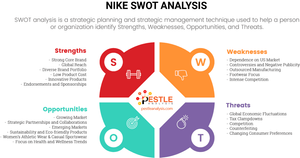Our SWOT analysis of Nike examines the Strengths, Weaknesses, Opportunities, and Threats influencing the sportswear giant's business.
In this article, we'll conduct a SWOT analysis of Nike, where we look at the Strengths, Weaknesses, Opportunities, and Threats influencing Nike's business. Today's analysis will give us a balanced insight into Nike's future possibilities and help us better understand its current and future business decisions.
Nike is truly a leader in the footwear and sports apparel markets. In the fiscal year 2024, Nike reported a notable financial performance.
Revenues reached $13.4 billion on a quarterly basis, marking a modest but welcome 1% increase on a YoY basis. Meanwhile, earnings per share beat expectations significantly ($0.98 vs $0.69 expected). Nike's popular catchphrase "Just Do It" and powerful celebrity endorsements continue to make the sportswear giant a household name across much of the world.
With that in mind, today's SWOT analysis of Nike will:
- start with the strengths that underscore Nike's dominance in the global sportswear market
- move to the weaknesses that present hurdles to its growth and efficiency
- discuss the opportunities that the evolving sports and fitness world offers, and
- reveal the threats in an industry known for its fierce competitiveness and rapid innovation
By examining these influences, we will also investigate what's achievable in the spheres of sports, lifestyle branding, and athletic technology. In the meantime, I've written everything you need to know about SWOT here.
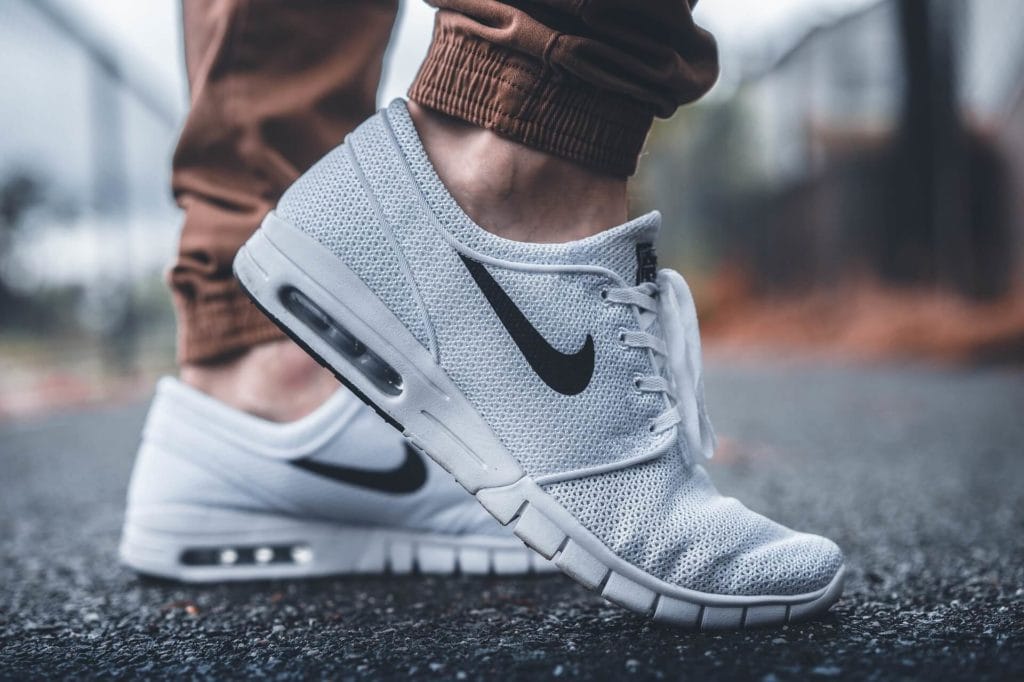
Nike Strengths
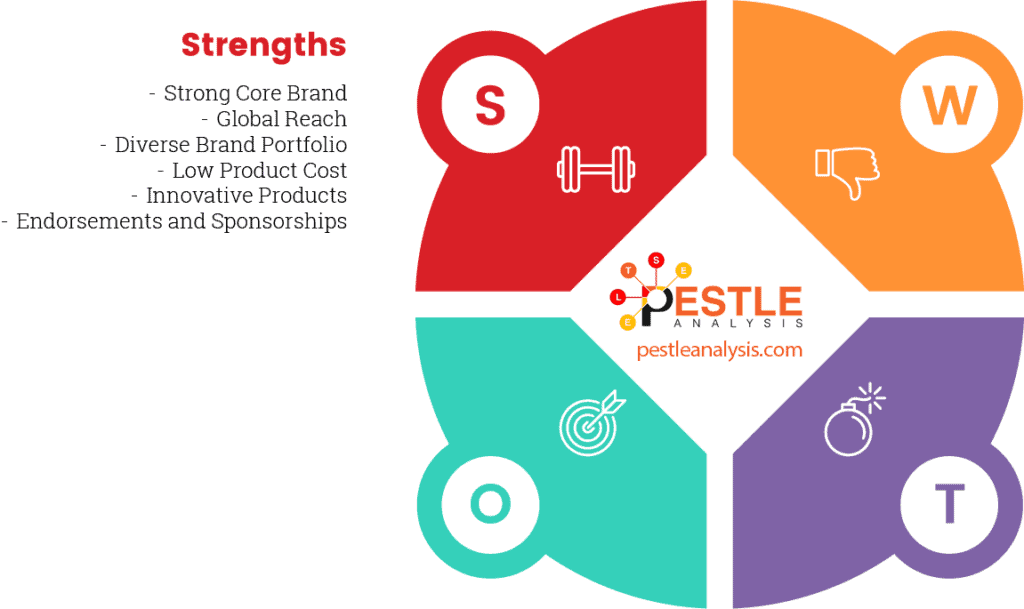
Did you know that Phil Knight, the co-founder of Nike, was talked out of naming the company "Dimension 6" in favor of Nike?
Now that you know let's start the SWOT analysis of Nike with the brand's strengths, the first section of every SWOT. Needless to say, the most important strengths are Nike's powerful brand and low product cost.
Strong Core Brand
The Nike brand itself is one of the strongest — if not the strongest — names in the entire sportswear industry. Across much of the world, Nike is one of the first companies to come to the public's mind when they think of hip, sporty footwear. Overall, this extremely powerful core brand is one of Nike's biggest strengths, and you can bet that helps them rake in billions in additional revenue every year. Its iconic "Swoosh" logo and "Just Do It" slogan are known globally, contributing to its strong brand presence.
Global Reach
Nike's products are available worldwide through retail stores and online platforms. This vast distribution network is surely a strength as it ensures that a global customer will have access to its products.
Diverse Brand Portfolio
Although the Nike brand itself is incredibly strong, the company has a diverse brand portfolio beyond that. Most notably, this brand portfolio includes Converse as well as dozens of other Nike-centric sub-brands such as Nike Shox, Nike Blazers, and Nike Tiempo. This suggests that Nike has its foundations well spread across the footwear industry, allowing it to painlessly weather changes in preference.
Low Product Cost
Since many of Nike's products are manufactured in developing Southeast Asian countries such as Indonesia and Thailand, Nike has extremely low labor costs. What's more, Nike also uses relatively inexpensive materials for many of its shoes. Together, these two factors — labor cost and material cost — allow Nike to manufacture its footwear for extremely low prices.
Innovative Products
Nike is renowned for its innovation in product design and technology. From the Dri-FIT technology to the Air Max DN shoe announced in March 2024, Nike has introduced groundbreaking products. This has allowed Nike to set trends in the sportswear industry.
Endorsements and Sponsorships
Nike has a long history of sponsoring high-profile athletes and sports teams. From Michael Jordan to Serena Williams and agreements with teams like FC Barcelona, these partnerships have solidified Nike's position as a key player in the sports world. In 2024, Nike took the place of Adidas as the sponsor of the German football team, ending a 77-year-old partnership!
Nike Weaknesses
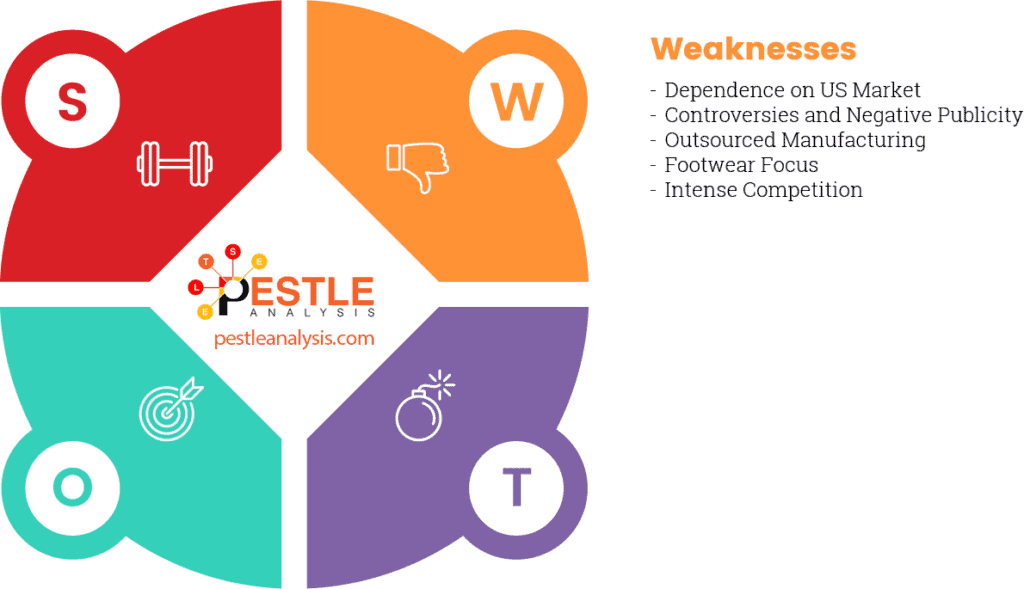
Did you know that the Swoosh outlines the "swooshing" sound you might hear as an athlete speeds past, adding an auditory dimension to the brand's identity?
Now that you know, we move to the second type of internal factors affecting the company in our SWOT Analysis of Nike.
As you'd expect, Nike does indeed have some weaknesses. It's dependent on the US market, its manufacturers, and the footwear industry.
Dependence on the US Market
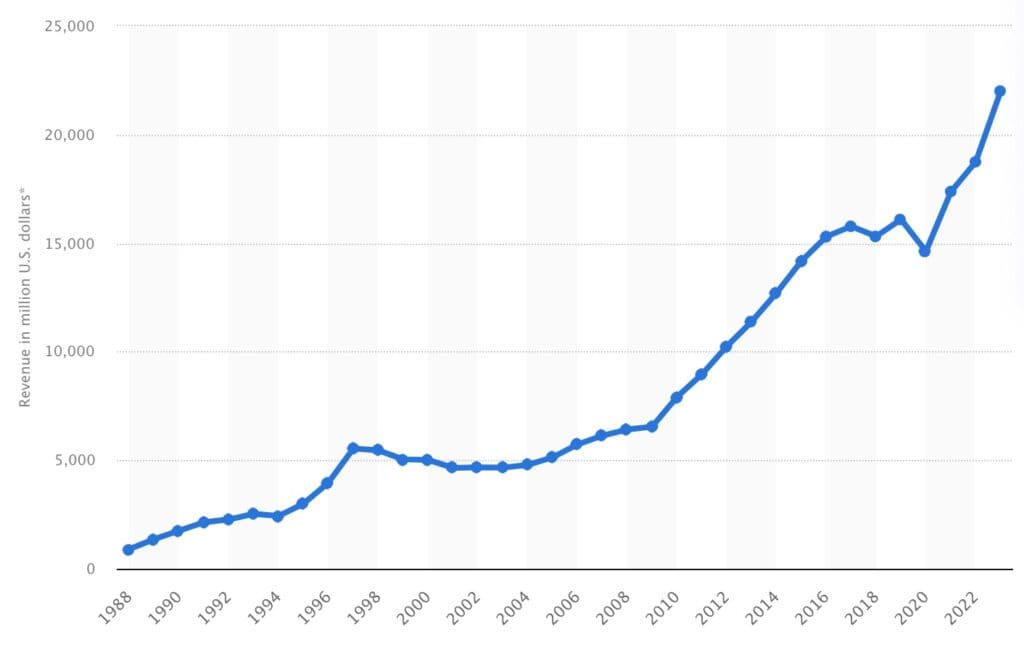
In 2018, over 40% of Nike's revenue came from the US market. This increased to 43% in 2023. As you can imagine, this demonstrates a huge dependence on the US market as part of Nike's business model. If American tax or legal policies were to change, in any way affecting Nike's ability to sell on the US market, that would significantly hurt the sportswear giant's profits.
Controversies and Negative Publicity
Over the years, Nike has faced several controversies related to labor practices and working conditions. Allegations of poor working environments and exploitation in factories have led to negative publicity. Although Nike has taken steps to address these issues, such controversies can tarnish the brand's image and consumer perception. In 2023, Nike critics launched a 'burn bra challenge' and railed against its treatment of female athletes.
Outsourced Manufacturing
Despite the low cost associated with manufacturing products abroad, there are indeed downsides to doing so. For one, manufacturing abroad requires you either to set up dedicated manufacturing operating in your chosen country or to outsource your work to existing manufacturers. Nike has chosen to do the latter, which means that their products aren't always top quality.
Footwear Focus
Although Nike is relatively diversified within the footwear industry itself, Nike has not diversified itself much across other industries. Although the footwear industry is probably here to stay, Nike may consider broadening their horizons.
Intense Competition
The sportswear and athletic footwear markets are highly competitive. Nike competes with major global brands like Adidas, Under Armour, and Puma, among others. This competition pressures Nike to continually innovate and invest in marketing to maintain its market position, which can strain resources and affect profitability.
Nike Opportunities
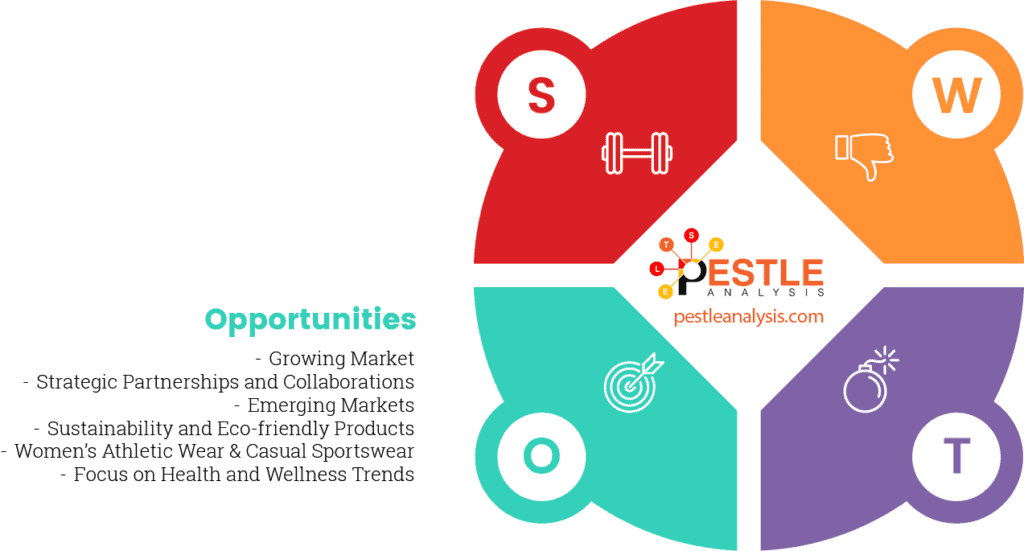
Did you know that the very first NikeTown, which opened in Oregon in 1990, was not just a retail store but a sort of museum and interactive experience, pioneering a retail concept that many brands have since tried to emulate?
Now that you know, we move to the third section of today's SWOT Analysis of Nike.
Nike has a growing market in all senses, thanks to healthier consumers and wealthier countries. This presents a few new opportunities.
Growing Market
There are only more and more people in this world, and many of them (especially in developed countries) are becoming gradually more active. Together, these two factors compound to create a constantly growing footwear market. If played correctly, Nike should be able to capture much of the business of this growing market, allowing the company to further grow its profits.
Strategic Partnerships and Collaborations
Collaborating with fashion designers, celebrities, and other brands can open up new markets and demographics for Nike. Limited edition releases and exclusive collaborations can generate buzz and attract customers looking for unique products.
Emerging Markets
As countries across the world become wealthier and wealthier, citizens in developing countries have more disposable income. In areas such as South East Asia, growing disposable incomes present an opportunity for new markets in which to sell products. If Nike is able to market themselves in these emerging markets, they could grow their reach and reduce dependence on the US market.
Sustainability and Eco-friendly Products
In many Western countries, there is a growing trend of knowing where products have come from and how the environment and workers have been treated. This presents another opportunity for Nike. If they are able to brand themselves as a responsible manufacturer of sportswear goods, they may be able to increase their market penetration among more ethically and environmentally conscious consumers.
Women’s Athletic Wear and Casual Sportswear
The women’s athletic wear market and the casual sportswear (or "athleisure") segment are growing rapidly. Nike can further develop and market products specifically designed for women, tapping into this expanding market segment to drive sales.
Focus on Health and Wellness Trends
The global emphasis on health and wellness, accelerated by the COVID-19 pandemic, presents an opportunity for Nike. It can position itself as a partner in consumers' fitness and wellness journeys. Offering products and services that support a healthy lifestyle, such as fitness apps or community events, can enhance brand loyalty and customer engagement.
Nike Threats
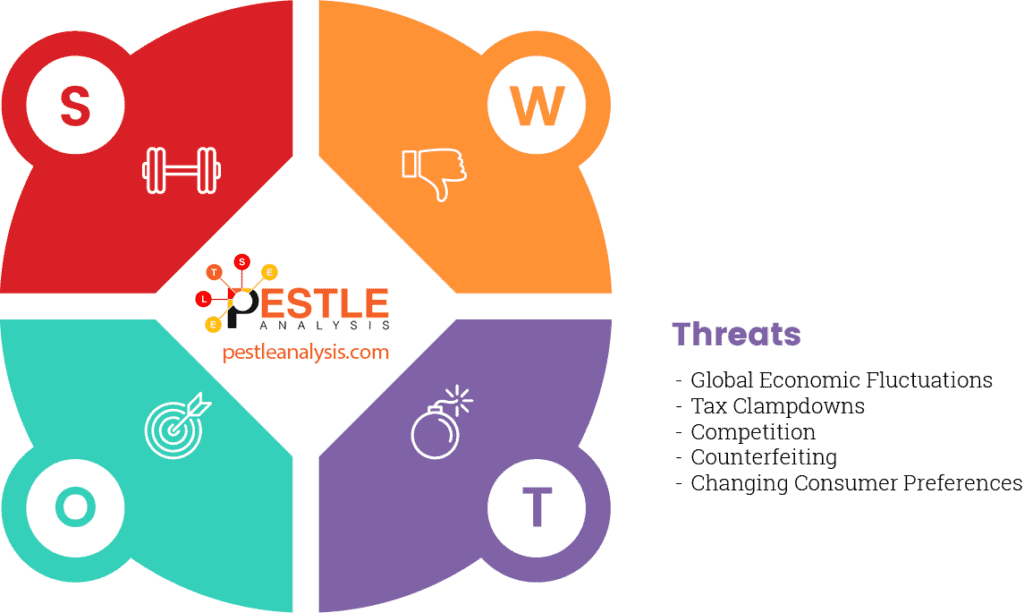
Did you know that in 1985, Nike created a special pair of Air Jordan 1s for Michael Jordan to wear during the Grammy Awards that made it easier for Jordan to play the guitar during his performance?
Now that you know, it's time to talk about the final part of the SWOT Analysis of Nike. For threats, Nike has to look in all directions: tax, market competition, and product counterfeiting.
Global Economic Fluctuations
Economic downturns, fluctuations in currency exchange rates, and trade disputes can significantly affect Nike's sales and profitability. As a global company, Nike is exposed to the risk of economic instability in key markets, which can lead to decreased consumer spending and disruptions in the supply chain.
Tax Clampdowns
Like many other big companies, Nike has its tax strategies optimized down to the dollar. This has for many years allowed Nike to avoid paying large amounts of tax, even on its billion dollar profits. However, there is growing controversy about the amount of leeway large organizations are afforded when it comes to tax matters, and their freedom to pay low amounts of tax may one day come to a close. This would afford Nike significantly smaller net profits.
Competition
Nike is competing in the fiercely competitive sports apparel market, with other big names such as Adidas, PUMA, and Reebok ready to pounce on any new opportunities. As such, Nike needs to tread extremely carefully to ensure it isn't replaced by one of these, or — somewhat less dramatically — doesn't lose out on potential revenue.
Counterfeiting
Like many valuable branded goods, Nike apparel is subject to large amounts of counterfeiting. Counterfeit Nike goods are available everywhere — even on the internet. Nike needs to develop a strategy to ensure that the counterfeiting of their goods doesn't affect their core business model, perhaps by taking legal action against counterfeiters or with a clever marketing campaign that encourages consumers to buy the real thing.
Changing Consumer Preferences
Consumer tastes and preferences in the sportswear and footwear industries are constantly evolving. A failure to anticipate or quickly respond to these changes can result in lost sales and inventory surplus.
This concludes the four parts of a SWOT analysis for the Nike company.
Recommendations based on the SWOT Analysis of Nike
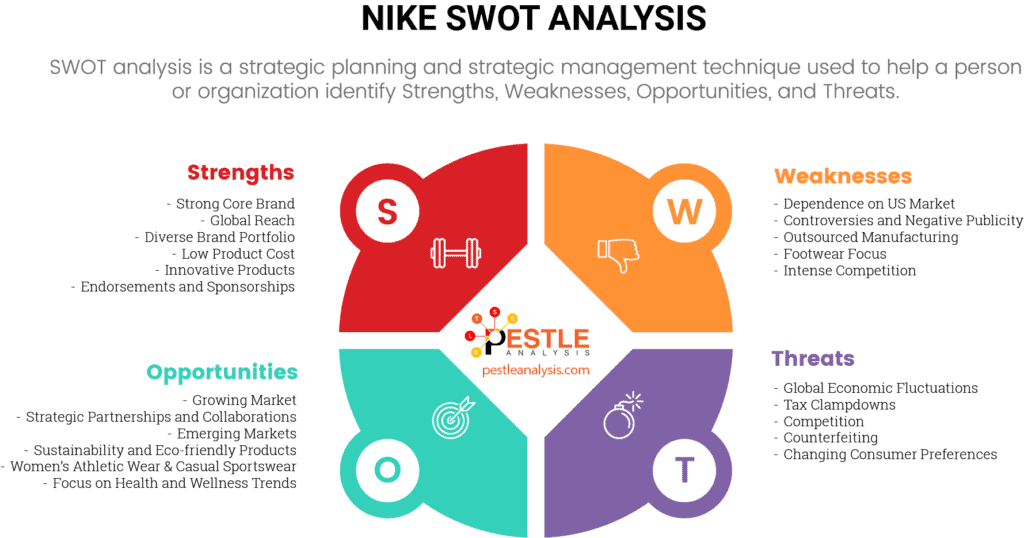
Nike is a giant organization competing in a tough market, but it's doing incredibly well. With its extremely powerful brand and low costs, Nike has been able to net several billions of dollars on an annual basis.
Unfortunately, Nike is very much dependent on the US market and is little diversified beyond the footwear and sports apparel markets. Nike needs to watch out for threats associated with these weaknesses, and others such as tax clampdowns or counterfeiting.
Thankfully, Nike has several opportunities for growing its business, including making the most of the rapidly expanding sportswear market.
Based on the SWOT analysis of Nike, here are actionable recommendations for Nike to bolster its strengths, address its weaknesses, capitalize on opportunities, and mitigate threats:
- Enhance E-commerce and Digital Engagement: Invest further in digital platforms and e-commerce to strengthen direct-to-consumer (DTC) sales channels. They should be enhancing the online shopping experience, leveraging AI for personalized marketing, and utilizing social media for engaging storytelling to attract more customers online.
- Expand Sustainable Product Lines: Continue to expand the range of sustainable and environmentally friendly products.
- Accelerate Expansion in Emerging Markets: Focus on expanding presence in emerging markets with high growth potential.
- Innovate Through Technology: Continue to lead in innovation by investing in research and development (R&D) for new materials, product designs, and technological advancements in wearable technology.
- Address and Communicate on Ethical Practices: Proactively address labor practices and working conditions in the supply chain. Implementing transparent reporting and third-party audits can build trust and improve public perception. Engaging in corporate social responsibility (CSR) initiatives can further demonstrate Nike's commitment to ethical practices.
- Foster Inclusive and Diverse Branding: Ensure branding and product lines are inclusive, catering to a diverse range of consumers in terms of gender, body type, and cultural background. Inclusive marketing and product diversity can broaden Nike's appeal and strengthen its global brand image.
Time to wrap up our SWOT analysis of Nike, by checking out previous SWOT analyses we've conducted for Nike's competitors:
- SWOT Analysis of Adidas
- SWOT Analysis of PUMA
- SWOT Analysis of Under Armour
- SWOT Analysis of Lululemon

